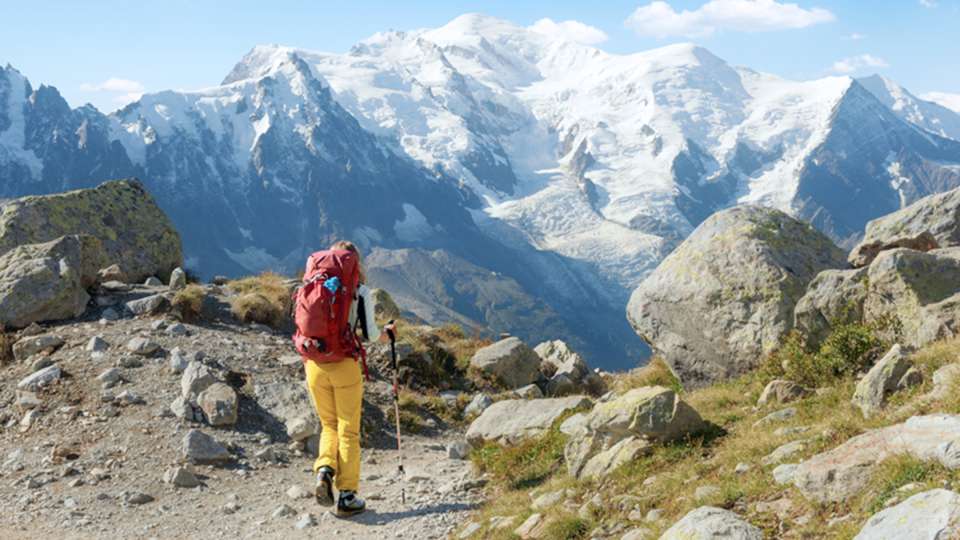
Planning on traveling to new heights? Whether your next adventure is trekking to Machu Picchu, summiting Mount Rainier, or going for a cozy mountain cabin getaway in Aspen, if your travels take you more than 8,000 feet above sea level, altitude sickness is a potential concern.
Dr. Andrew Luks, a physician at the Chest Clinic at Harborview Medical Center and professor of Medicine in the Division of Pulmonary, Critical Care and Sleep Medicine at the UW School of Medicine, says if you don’t want altitude sickness to ruin your high-altitude plans, it’s essential to be able to recognize the signs of altitude sickness, know how to prevent it and understand how to respond if symptoms develop.
What is altitude sickness?
The low oxygen levels found at high altitudes can be problematic for travelers. Even if you aren’t doing an intense activity like summiting a mountain, just being at or higher than 8,000 feet above sea level can put you at risk for altitude sickness.
There are three types of problems that can develop from acute altitude illness or altitude sickness: acute mountain sickness, high-altitude cerebral edema and high-altitude pulmonary edema.
Acute mountain sickness can feel a lot like a hangover with symptoms like headache, persistent lightheadedness, dizziness when sitting up, feeling sick to your stomach, and just generally feeling off or blah.
High-altitude cerebral edema (HACE), a swelling of the brain that causes neurologic dysfunction, is one of the more severe forms of altitude sickness that can develop. Symptoms of HACE include loss of coordination (ataxia), drowsiness, confusion and, in very severe cases, altered levels of consciousness including coma.
High-altitude pulmonary edema (HAPE), fluid buildup in the lungs that lowers oxygen levels in the blood and makes it hard to breathe, is the other more severe form of altitude sickness. Symptoms of HAPE include shortness of breath (out of proportion to that expected for a given elevation), worsening exercise tolerance, weakness and cough.
These problems might start to occur when the body doesn’t have enough time to adjust to the changes in air pressure and oxygen levels. It’s important to know these symptoms so you can take appropriate action if you were to get sick.
“The good news is that acute mountain sickness, which is by far the most common problem that happens to people at high altitude, is usually mild and not a severe problem. With appropriate treatment and management, it usually goes away without any lasting problems,” says Luks. “The risk is if someone does not take appropriate steps or continues to ascend. HACE and HAPE are both very uncommon, but it’s important to be able to recognize them and take appropriate action because they can cause serious problems."
What to do if you have altitude sickness
If you are at a high altitude and start to get that hangover feeling sans alcohol, the first thing you should do is to stop going up in elevation.
Luks says that once you have stopped your ascent, you can treat your symptoms with medicine. For example, you could take ibuprofen or acetaminophen to treat your headache. In severe cases, it might be worth taking acetazolamide or dexamethasone, medications that help treat the symptoms of acute mountain sickness and can be prescribed by your primary care doctor or through a travel medicine clinic.
Your next step? Stay put and wait it out. If your symptoms get better within a day or two, then that’s your green light to continue up.
If your symptoms start to get worse or you have symptoms and signs of HACE or HAPE, it’s important to get down to a lower elevation and to a health facility if there is one accessible.
“The only time people with acute mountain sickness need to descend is if their symptoms don’t get better doing those conservative things; in other words, if they stop going up in elevation, they take ibuprofen or acetaminophen for their headache, or acetazolamide or dexamethasone, and their symptoms stay the same or get worse, then they need to go down in elevation,” says Luks.
When are you most at risk for high altitude sickness?
No matter the elevation above 8,000 feet, the person’s fitness level or genetic predisposition, ascending too quickly (and staying at high altitude) is what puts people the most at risk for altitude sickness.
According to Luks, your risk of developing acute mountain sickness could be anywhere from 20-70% depending on the altitude reached and the rate of ascent.
Studies done at ski resorts in Colorado or with people summiting Mount Rainier have a lower rate of developing acute mountain sickness (around 20-40%) compared to studies conducted with people trying to summit Mount Kilimanjaro (where incidence rates can be as high as 60-70%). The difference is due to the practice of overly fast ascent rates used by most guiding companies who take people up Mount Kilimanjaro.
“If you go up slowly you are giving your body time to adjust to low oxygen conditions — we refer to that as acclimatization — but if you plan on staying at altitude and ascend too quickly and don’t give your body time to adjust, that’s when these maladaptive responses occur and you develop acute mountain sickness, high-altitude pulmonary edema or high-altitude cerebral edema,” he says.
How to prevent altitude sickness
We’ve said it before, and we will say it again: the main reason people get sick is they go too high too quickly.
For example, person A and person B are both traveling to a location 15,000 feet in elevation from sea level. If person A makes the ascent in two nights and person B makes the ascent in five nights, person A is way more likely to get sick than person B.
Following that logic, the best thing you can do to prevent altitude sickness is slow down your ascent when feasible.
If a slow ascent isn’t possible because you are flying into your destination or have traveled to high altitude before and have a history of acute altitude sickness, medications like acetazolamide, also called Diamox, are good preventive options.
Myths, medications and medical conditions
There is a lot of information about altitude illness prevention out there, but most of the systematic studies and literature don’t show that it works, says Luks. But some commonsense actions do apply.
Myth: hydration prevents acute mountain sickness
Staying hydrated is a good thing. However, when it comes to avoiding acute mountain sickness, hydration has never been shown to work, says Luks. But don’t put down the water bottle just yet.
It’s easy to become dehydrated at high altitudes. As you go up, the air is less humid and you are breathing more so you lose moisture from your respiratory tract, you might also be doing physical activity that further adds to the risk of dehydration.
“Staying well-hydrated is good to prevent dehydration,” he says. “Dehydration symptoms could fool you into thinking you have acute mountain sickness and can also limit your exercise tolerance.”
Dehydration and acute mountain sickness symptoms are a lot alike (think of that hangover feeling), so drinking fluids is important to prevent dehydration, so you don’t confuse it with acute mountain sickness.
Myth: abstaining from alcohol prevents acute mountain sickness
Luks says that mild alcohol consumption is OK at high elevations. What does concern him, though, is drinking excessively before bedtime.
“Too much alcohol consumption before bed might suppress someone’s breathing while they sleep. At high altitude your body is trying to breathe more to get more oxygen into the system and if you do anything that suppresses your breathing, particularly when you sleep, the oxygen levels are going to go down in your blood and that can spur along some of the processes that lead to altitude illness,” says Luks.
For similar reasons, using opiate pain medications or sedative medications at high altitudes also risks decreasing your breathing and can pose problems.
Myth: people with medical conditions shouldn’t travel to high altitude
“There is this concern that people with medical conditions shouldn’t go to altitude, but it turns out that for the majority of common conditions like diabetes, high blood pressure, asthma, etc., high altitude doesn’t pose a significant risk to those people, especially if their disease is under control at the time they go to high altitude,” says Luks.
There are a few conditions though where Luks suggests taking a cautious approach: advanced chronic obstructive pulmonary disease, heart failure, pulmonary hypertension or sickle cell anemia. If you make a careful ascent plan, dial down physical activity when you get to high altitude, have plans for managing your medications and accessing medical care if you get sick, high-altitude travel can still be safe.
“There has also always been this concern about traveling to high altitude while pregnant and if you look at guidelines, they will often say avoid travel to high altitude during pregnancy,” says Luks. “I think those concerns are typically a bit overstated.”
Traveling to a high altitude during pregnancy can be safe under a couple of conditions: First, it must be a low-risk pregnancy. If the pregnant person has had problems in earlier pregnancies with preeclampsia, premature contractions or gestational diabetes, or is having trouble with these issues during their current pregnancy, then high altitude travel is not advised.
Second, if the pregnancy is low risk and the pregnant person is healthy, they can go up to moderately high elevations like 8,000-10,000 feet. It’s important to dial back the physical activity for the first couple of days and let the body adjust to the altitude.
“Most importantly, they should not engage in a level of exertion that is higher than what they would typically do at sea level,” says Luks. “If you aren’t a runner at sea level, don’t go up to altitude and run a 5K race. Take steps to maintain adequate hydration and pay attention to symptoms of altitude illness and get down to lower elevations if symptoms occur.”
Myth: people on medications shouldn’t travel to high altitude
Most medications are generally safe to use at high altitudes. If you have a medical condition that you are taking medicine for at the time of travel, Luks says you should continue to take those medications as prescribed.
“Where you run into some concerns is if someone starts taking medication to prevent altitude illness, there could be an interaction with the medication they are already taking. These interactions are not common, but there is a potential for them,” he says.
If you are taking medications, it’s good to talk to a doctor or pharmacist before the trip, just in case you also need to take medications to treat altitude illness.
A common medication that gets talked about in high-altitude settings are birth control pills. This is because hormonal birth control is thought to increase the risk of blood clots, particularly in people who smoke cigarettes, and there has long been speculation that high altitude predisposes people to blood clots as well.
“Again, I think the risk is overstated; it hasn’t been systematically demonstrated in the literature. Many people can travel to high altitudes on oral contraceptives, and they do just fine,” says Luks. “The key thing is to maintain physical activity, move around and keep hydrated — do the things that are typically known to prevent blood clots in the first place.”
When to see a doctor before high altitude travel
If you have never been to high altitude before, it’s a good idea to talk to your primary care doctor or a travel medicine clinic to get counseling about altitude illness and how to recognize, prevent and treat problems. And, if necessary, get a prescription of medications for prevention and treatment if problems develop.
If you are someone who has had recurring altitude sickness, it’s also a good idea to talk to your doctor about how to manage that.
The more you travel to high altitudes, the more you will learn about your tolerance level and when and how to adapt and plan accordingly.
So take the trip and explore new heights (while taking it slow and knowing the signs of altitude illness, of course).

 Healthy ideas for your inbox
Healthy ideas for your inbox





